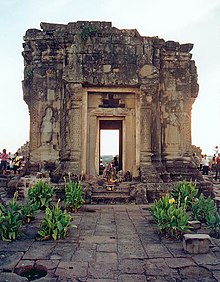Phnom Bakheng
The pyramid temple Phnom Bakheng , consecrated to Shiva , is located on the hill of the same name near the Cambodian city of Siem Reap , west of the road between Angkor Wat and Angkor Thom . The Khmer word "Phnom" denotes a rapidly rising elevation.
history
King Yasovarman I (reign from 889 to around 915) moved the capital of his empire from the not far away Roluos to the area that is now called Angkor ; He had temples built on all four hills overlooking the plain: on the Phnom Dei in the north, the Phnom Bok in the east, the Phnom Krom in the south and the Phnom Bakheng in the west. He chose the latter 55 m high hill as the location of his new state temple; All around he had his new capital Yasodharapura built, a square with a side length of 4 km (and thus larger than the later capital Angkor Thom).
During the reign of terror of the Khmer Rouge , Phnom Bakheng was a strategic fortress: From here you could see far into the country in all directions.
architecture
The builders used the rock substance of the hill to construct an impressive pyramid temple. The approximately 200 by 100 m platform on the top of the hill is carved out of the rock, the five-tier pyramid was left standing: at the base 76 by 76 m, from the base to the top step 13 m high. The attempt to make the pyramid appear higher by means of a perspective illusion is interesting : the height of the pyramid steps decreases towards the top; the lions guarding the stairs also get smaller and smaller towards the top.
The sides of the platform and the pyramid face the cardinal points; the 70 ° steep stairs lead up to the central sanctuary on all four sides. This architecture symbolizes in its alignment harmony with earth and sky, in its structure the path leading to the center and up to the gods who live on Mount Meru .
In addition to the central Prasat, the temple has 108 other towers. 108 is a sacred number in Hinduism - as in Buddhism . The stable underground of the Phnom Bakheng certainly played a major role in the decision to implement the number 108 in towers. There are 44 brick towers grouped around the base of the pyramid, 11 on each side; 60 small sandstone towers stand on the pyramid steps, flanking the stairs and decorating the corners; The first Prasat quincunx in Angkor's architectural history rises on the top step : five towers, arranged like five points on the surface of a cube, the central sanctuary larger than the corner towers - this arrangement became characteristic of all later state temples. The physician and Indologist Jean Filliozat took the view that from all points of view only 33 of the 108 towers are visible; this is the number of gods in Indra's heaven.
In the 16th century, attempts were made to erect a large, seated Buddha that completely covered the top of the pyramid ; apparently they used sandstone blocks from the five central towers, of which only ruins remain. The large statue was never completed and was removed during restoration work . During the recent wars, the Phnom Bakheng was further destroyed, adding to the ruinous impression.
On the east side of the platform, two so-called libraries have been preserved, with diamond-shaped openings in the walls. There is a sandstone lingam near the northeast library . The outer walls of the central sanctuary show sandstone reliefs of Devata and Apsara , the first representations of this kind.
tourism
The view from Phnom Bakheng is popular with tourists, who usually climb the hill at the end of a sightseeing tour to watch the sunset. Angkor Wat can be seen to the southeast . The stairs that lead directly up on three sides have meanwhile been blocked to protect them from further deterioration; a fourth, southern staircase was probably planned, but was not built. There is a new, flatter path for tourists.
Individual evidence
- ^ So Charles Higham: Encyclopedia of Ancient Asian Civilizations (see bibliography).
- ↑ Reported in Charles Higham: Encyclopedia of Ancient Asian Civilizations (see bibliography).
literature
- Michael Freeman and Claude Jacques: Ancient Angkor . River Books, Bangkok 1999, ISBN 974-8225-27-5 .
- Charles Higham : Encyclopedia of Ancient Asian Civilizations . Facts on Files, New York 2004, ISBN 0-8160-4640-9 , article "Bakheng".
- Luca Invernizzi Tettoni and Thierry Zéphir: Angkor. A tour of the monuments . Archipelago Press, Singapore 2004, ISBN 981-4068-73-X .
- Johann Reinhart Zieger: Angkor and the Khmer temples in Cambodia . Silkworm Books, Chiang Mai 2006, ISBN 974-9575-60-1 .
Web links
- Jean Filliozat : Le symbolisme du monument du Phnom Bàkhèn. In: Bulletin de l'École française d'Extrême-Orient Vol. 44 No. 2. Paris 1951, pp. 527-554. Article on persee.fr, as of August 22, 2010.
- Claude Jacques: History of the Phnom Bakheng Monument. In: Phnom Bakheng Workshop on Public Interpretation. Siem Reap 2006, pp. 23-40. Article on khmerstudies.org, as of August 22, 2010.
Coordinates: 13 ° 25 ′ 25.7 ″ N , 103 ° 51 ′ 21.6 ″ E





